Hack:
The Work Culture: Unraveling the Unlimited Human Potential for Sustained Organizational Performance
Sustained optimum organizational performance is presented as the product of a knowledge revolution, where energy links the knowledge tripod; including nature, humans, and society. Energy transfer from nature to society is effected via the factor-F; which is nurtured by learning, in a culture with the natural order as its kernel.
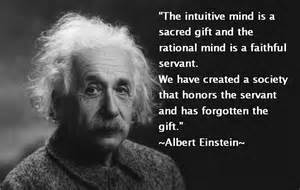 Copernicus opened up the clear understanding of nature, with his heliocentric model of the universe. Einstein sealed it with the energy equation, e = mc2. Inputs from Plato, Feynman, and our own dear Stephen Hawking concluded the process, enabling de-Broglie to observe that every natural phenomenon is a wave. This understanding became evident in the industrial revolution, which mechanized the way of doing things. It has become possible to generate energy, and to direct it deliberately towards the accomplishment of tasks. And with the gear system, mechanical motion became possible. Moreover, the information revolution has stretched this success to its limits. The six sigma, 6σ paved this path with a focus on process, which is able to minimize waste, reducing it to as few as two, 2 defective products per production cycle.
Copernicus opened up the clear understanding of nature, with his heliocentric model of the universe. Einstein sealed it with the energy equation, e = mc2. Inputs from Plato, Feynman, and our own dear Stephen Hawking concluded the process, enabling de-Broglie to observe that every natural phenomenon is a wave. This understanding became evident in the industrial revolution, which mechanized the way of doing things. It has become possible to generate energy, and to direct it deliberately towards the accomplishment of tasks. And with the gear system, mechanical motion became possible. Moreover, the information revolution has stretched this success to its limits. The six sigma, 6σ paved this path with a focus on process, which is able to minimize waste, reducing it to as few as two, 2 defective products per production cycle.
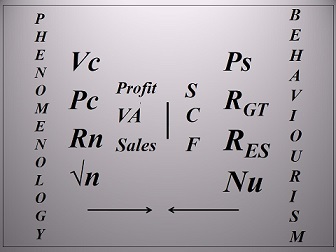 But nature is only one, 1 leg of the tripod that describes knowledge. The other two, 2 include humans, and society. And the connecting strand is energy. Thus, the knowledge revolution, which would be the third, 3rd in the series, would be fully underway only when the energy transfer from nature, through humans to society, is clearly defined. This process has been stalled by the paucity of information about people and society. This lag became inevitable when psychology shifted its gaze from phenomenology to behaviorism, for the lack of appropriate methodology. Precision with humans and society has awaited a clear definition of mind, in the same way that Einstein defined nature. This is because the mind is the medium for energy transfer, from nature, through humans, to society.
But nature is only one, 1 leg of the tripod that describes knowledge. The other two, 2 include humans, and society. And the connecting strand is energy. Thus, the knowledge revolution, which would be the third, 3rd in the series, would be fully underway only when the energy transfer from nature, through humans to society, is clearly defined. This process has been stalled by the paucity of information about people and society. This lag became inevitable when psychology shifted its gaze from phenomenology to behaviorism, for the lack of appropriate methodology. Precision with humans and society has awaited a clear definition of mind, in the same way that Einstein defined nature. This is because the mind is the medium for energy transfer, from nature, through humans, to society.
Immanuel Kant had a glimpse of the connection that links nature, and society through humans; when he distinguished between the personal order, P-O and the natural order, N-O as phenomena and noumena, respectively. He also alluded to the significance and illusory character of this link when he pointed to the distant future, for its definition. He suggested that nature had a secret plan, which would culminate in the derivation of a culture, in which it would be possible to socialize the model human. Then, the harmony and stability that people seek in society, would become possible.
 The second, 2nd law of thermodynamics defines the limit of entropy that nature can contain. When this is exceeded, instability and disharmony abound, proportionately. Entropy is evaluated as the extent of deviance of the P-O from the N-O. As the P-O approximates the N-O more closely therefore, the entropy that is contributed is minimized accordingly. This becomes the human potential toward which up-bringing ought to strive; for the P-O to approximate the N-O. Moreover when this happens, the sustained optimum performance at task can be achieved, for business growth and continuity.
The second, 2nd law of thermodynamics defines the limit of entropy that nature can contain. When this is exceeded, instability and disharmony abound, proportionately. Entropy is evaluated as the extent of deviance of the P-O from the N-O. As the P-O approximates the N-O more closely therefore, the entropy that is contributed is minimized accordingly. This becomes the human potential toward which up-bringing ought to strive; for the P-O to approximate the N-O. Moreover when this happens, the sustained optimum performance at task can be achieved, for business growth and continuity.
Humans have been wired to act, using procedures that are internalized. This means that people respond to stimuli according to the processes that they have stored away in the sub-conscious memory of the emotion, L. Although the procedure or process is derived in the conscious memory of the intellect, F with energy, C that is supplied by the unconscious memory of the will, A behavior is not rooted directly in these two, 2 components of the mind. But for the intellect to derive the appropriate procedure, 100% attention would be required, for the period, according to the pace of the learner and person involved. And this would be possible only when the will is equally committed, C. In this case, the appropriate procedure would be the standard procedure, which is the analogue of the N-O.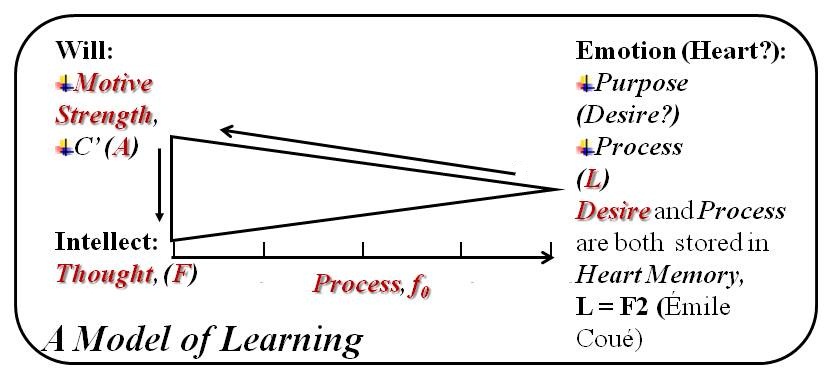
he natural order, N-O comprises the essential components of the phenomenon in question, which give it being. By the perception model of mind, PMM when correctly identified, they are five, 5 in number. And when properly arranged into a series so that they concatenate into the phenomenon that is described, which then becomes the sixth, 6th item in the series, this defines the standard procedure series, SPS. Thus given the required strength, C of will, A the intellect, F would at once characterize, F^2 the phenomenon and derive the standard procedure, F^n which is then stored in the emotion, L. These define the analytic, F1 and synthetic, F2 functions of the mind, respectively. To perform at these tasks optimally however, the mind is also perceptive, f1 and sensitive, f0. To put a value on the mind, these activities have been reconstructed as follows:
- C = A / 19 + 1
-
A = LF^2
- L = 1 / A2 F^2
- F^2 = F1 / F2
- A2 = f0f1
The model, L = 1 / A2 F^2 actually describes the person. It is the relativity model of humans, RMH. To empirically define the intellect, F in which mental analysis, F1 and synthesis, F2 are done, the personality model of society, PMS is derived as Rn = F√n. Rn is a measure of rationality, against the analytic capacity of the mind to reduce phenomena into the essential five, 5 components. And √n measures the performance at task by the standard procedure, against the synthetic function of the mind. Thus, the factors Rn and √n define equivalent concepts. This means that people who are rational, perform at task by the standard procedure, for Rn = √n: F =1. Then, the factor-F would deviate from a unity, for F > 1, as rationality decreases; with the attendant deviance from the performance at task by the standard procedure. The greater the deviance, the greater the entropy that is contributed to the society. This outlines how energy is transferred from nature, through humans to society. The factor-F does it. In the same way that mechanical motion resolved the human limitation with space, the limitations that time present are resolved by processes that approximate the standard procedure. When the essentials that define the standard procedure are derived correctly, change becomes inconsequential and time, a constant.
To establish this concept it was necessary to derive the following models:
- The productivity model puts a value on people uniquely, according to the observed gap created by the deviance from the N-O, which determines how productive people are.
- The leadership model demonstrates the authenticity of this measure, against Pareto’s 80–20 rule, as the 20%ters who do 80% of the work are easily identified as the leaders.
- Then, the bill of health index, BHI defines the operationalization of these concepts in organizations.
Thus for leaders in the professions, productivity would be optimum; which positions their organizations as leaders in the industries, according to their scores on the BHI. The index is derived from the following scores, which are easily accessible in the financial report:
- The total revenue,
- The profit before tax, and
- The value added, or cost of materials
Initial data has corroborated these conceptions reasonably, as can be seen on the model demonstrations linked above. A far greater challenge however lies in the roles of families and organizations in the fulfilment of this process.
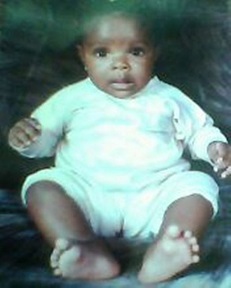 By this concept, organizations partner with homes, in the task of up-bringing. To raise children, to prepare them for work therefore, homes inculcate faith, F. This is a measure of dependability, according to the capacity of the intellect, F to reduce phenomena into the essentials. Then, organizations continue the process, via a work culture in which the following two, 2 rewards are obtainable:
By this concept, organizations partner with homes, in the task of up-bringing. To raise children, to prepare them for work therefore, homes inculcate faith, F. This is a measure of dependability, according to the capacity of the intellect, F to reduce phenomena into the essentials. Then, organizations continue the process, via a work culture in which the following two, 2 rewards are obtainable:
- Financial rewards, according to the return on investment, ROI contributed.
- Personal development, according to the synergy, SGYthat is benefitted.
While the 20%ters who form the leadership are rewarded essentially according to their contribution of ROI, the 80%ters are rewarded according to the synergy, SGY that they benefit, which is proportionate with their limitations. This is possible because of the following two, 2 features of the work culture:
- The appraisal model
- The knowledge bank
The knowledge bank is the systematic reduction of the essential jobs performed in the organization, into duties; which are also reduced into activities, and subsequently tasks. Then the procedure for the performance at each of the tasks is derived, to create the bank, which is the input to the following analyses:
- Skill gaps
- Performance appraisal
- Employment
- Reward
- Succession planning
- Capacity assessment
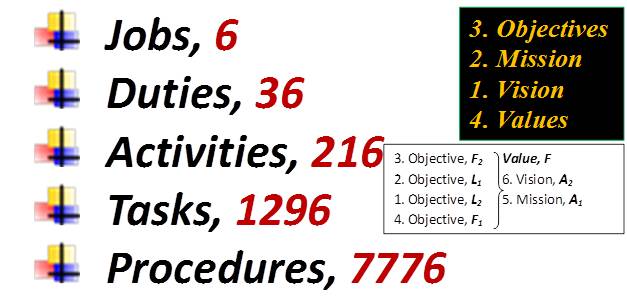 The jobs are derived according to the organization’s values, vision, mission, and objectives. And these are cascaded downwards, through the duties, activities, and tasks, to the procedures. The knowledge bank is created in collaboration with the leadership, who are also the domain experts in their professions. Then, workforce retention is assured, 100%. In this case it is expertize that is retained, and not the physical person. Moreover, alignment is also assured, together with the agility that results from the shared purpose. This is further enhanced by the appraisal model, which actually operationalizes the following two, 2 principles:
The jobs are derived according to the organization’s values, vision, mission, and objectives. And these are cascaded downwards, through the duties, activities, and tasks, to the procedures. The knowledge bank is created in collaboration with the leadership, who are also the domain experts in their professions. Then, workforce retention is assured, 100%. In this case it is expertize that is retained, and not the physical person. Moreover, alignment is also assured, together with the agility that results from the shared purpose. This is further enhanced by the appraisal model, which actually operationalizes the following two, 2 principles:
- One for all, all for one
- From each according to their ability, and to each according to their need
When the leadership work to derive the knowledge bank, and they benefit from their contribution of ROI, the second, 2nd principle is fulfilled for them. For the 80%ters, need is satisfied by the synergy gained, leading to expertize; and they are expected to contribute learning, for the fulfillment of the cycle and continuity. The appraisal model at once, measures the ROI that is contributed by each person, uniquely against their individual potentials; as well as against the performance of the workforce as a whole. This fulfils the first, 1st principle. Moreover, together, these principles further ensure workforce engagement by fostering another kind of alignment; between talent, profession, and job. This fit creates order and harmony, to minimize entropy contribution, for sustained optimum productivity.
The building blocks for understanding nature, humans, and society include as follows:
- Motion
- Time
- Space
- Energy
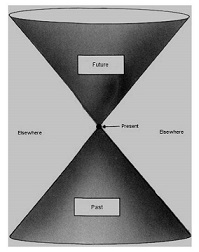 Space was conquered, when the gear system resolved the difficulty with motion. And now, time can also be conquered, because of the resolution of the problem with change, by the derivation of the standard procedure as a system of essentials. Both feats became possible by the resolution of the difficulty with energy, which is the link that connects the tripod of nature, humans and society. Notice that change is actually motion, in its intangible form; both of which happen in time and space, and require energy. Through understanding, mental energy is derived when physical phenomena are fissioned, to at once describe and procedurize them. Understanding is optimum when the items that describe the phenomena are the essentials, and the personal order match the natural order. Then according to the observed approximation, the energy is transferred to society, according to the resultant order and harmony. The family and the organization hold the key to this process. The work culture does it!
Space was conquered, when the gear system resolved the difficulty with motion. And now, time can also be conquered, because of the resolution of the problem with change, by the derivation of the standard procedure as a system of essentials. Both feats became possible by the resolution of the difficulty with energy, which is the link that connects the tripod of nature, humans and society. Notice that change is actually motion, in its intangible form; both of which happen in time and space, and require energy. Through understanding, mental energy is derived when physical phenomena are fissioned, to at once describe and procedurize them. Understanding is optimum when the items that describe the phenomena are the essentials, and the personal order match the natural order. Then according to the observed approximation, the energy is transferred to society, according to the resultant order and harmony. The family and the organization hold the key to this process. The work culture does it!

 This is a purely theoretical work. Unlike physics however, this fervor is not yet common with the humanities. But the underlying principles, as well as the maths, and simulations give credence to the approach. Moreover, the bill of health index, BHI is a purely empirical component of the work. It aptly demonstrates the fundamental principles highlighted. Thus, the index is better for organizations that have a semblance of the work culture described. It provides a safe and cheap point, from which to adopt the concept.
This is a purely theoretical work. Unlike physics however, this fervor is not yet common with the humanities. But the underlying principles, as well as the maths, and simulations give credence to the approach. Moreover, the bill of health index, BHI is a purely empirical component of the work. It aptly demonstrates the fundamental principles highlighted. Thus, the index is better for organizations that have a semblance of the work culture described. It provides a safe and cheap point, from which to adopt the concept.
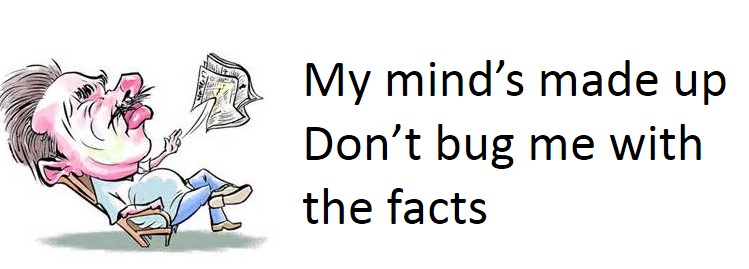
Faith, F is mentioned in this work, as an allusion to religion. It is however not a reference to merely religious faith. Rather, it is a non-dimensional factor that attempts to re-unite science and religion; which have remained apart since Hegel’s comment that ‘faith is one thing, and religion is another’. The natural order, N-O is actually a scientific rendition of the righteousness of God. Moreover, the whole concept presented here is an attempt to restore intuition, to its rightful place over and above rationality. And then to present both concepts as complements. Thus, the essentials are derived intuitively, by analysis. In synthesis however, the mind reverts to rationality; to put humpty dumpty back together again. In this way, the sacred is maintained; and the faithful servant, honoured, respectively. Recall Einstein in the following quote:
The intuitive mind is a sacred gift,
And the rational mind is a faithful servant.
We have created a society that honours the servant,
And has forgotten the gift.
The wave model defines the signature of the creator. The same scriptures that recommend the righteousness of God to humans, also describe God as love, L. This is a pure emotion, L that by nature, cannot exist alone; but must have an object, on which to bestow itself. This required the creator to clone Himself, in humans. Thus, the absolute does not make sense, without the relative. Neither does the size of the wave make sense, without its location. While the size factor is absolute and refers to the individual uniquely, the locational element of phenomena is relative, and describes it in relation to other phenomena of its kind. Both features must be present, for measurement to make sense. This is probably the reason that the wave is adequately defined by its size and locational features. Recall Stephen Hawkins in the following quote:
The uncertainty principle of quantum mechanics implies that certain pairs of quantities, such as the position and velocity of a particle, cannot both be predicted with complete accuracy.
The unpredictable, random element comes in only when we try to interpret the wave in terms of the positions and velocities of particles. But maybe that is our mistake: maybe there are no particle positions and velocities, but only waves
Recall also the following quote, about Feynman and the wave model:
Thirty-one years ago Dick Feynman told me about his 'sum over histories' version of quantum mechanics. "The electron does anything it likes," he said. "It just goes in any direction, at any speed, forward and backward in time, however it likes, and then you add up the amplitudes and it gives you the wave function." I said to him "You're crazy." But he isn't.

The scriptural concept of imagery alluded to above has two, 2 implications as follows:
- That humans have a certain potential that for most people, has remained unfulfilled
- That this potential can be fulfilled, given the appropriate conditions
The first, 1st implication may be adequately explained by the following quote:
Society is the product of the activities of humans in nature,
But in time it becomes a monster that makes people;
According to the culture, values, beliefs, norms, and mores,
Which are not necessarily optimised.
Agape Consultants
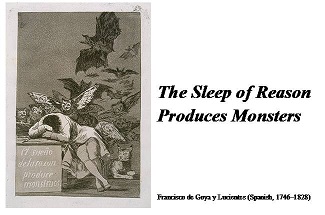
And the second, 2nd by the following, from Immanuel Kant:
The history of mankind can be seen, in the large, as the realization of nature’s secret plan to bring forth a perfectly constituted state as the only condition in which the capacities of mankind can be fully developed, and also bring forth that external relation among states which is perfectly adequate to this end.
A philosophical attempt to work out a universal history according to a natural plan directed to achieving the civic union of the human race must be regarded as possible and, indeed, as contributing to this end of nature.
Stephen Hawking also alludes to the possibility of closing the gap between the natural order and the personal order, and how this may be achieved, in the following quote:
In any population of self-reproducing organisms, there will be variations in the genetic material and upbringing that different individuals have.
These differences will mean that some individuals are better able than others to draw the right conclusions about the world around them and to act accordingly.
These individuals will be more likely to survive and reproduce and so their pattern of behaviour and thought will come to dominate.
Stephen Hawking on Charles Darwin’s natural selection
It feels safe then, to conclude this work with the following quote:
A God who is self-contained,
Created a universe that is self-contained.
When humans become self-contained,
They make institutions that are self-contained.
These will be institutions that are characterized by sustained optimum organizational performance. And a workforce that is self-contained would comprise 20%ters.
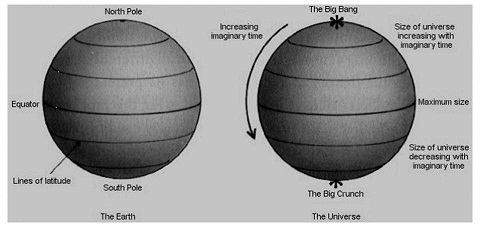
Simulation Data for BHI:
- Calibration Graphs Service Company.pdf
- Calibration Graphs Motor Company.pdf
- Calibration Graphs Cement Company.pdf
My Links:
Theoretical Papers
- The Bill of Health Index, HR Metrics that Motivate Optimum Productivity for Sustained Growth and Business Continuity: http://lnkd.in/cmanRJ
- The Mind: A Perception Model: http://www.docstoc.com/docs/161939196/They-perform-at-task-by-the-standard-procedure
- The Model Human, A Thinker and a Learner: http://www.docstoc.com/docs/162975139/The-Model-Human-A-Thinker-and-a-Learner
- The Objectivity Dilemma: http://posts.fanbox.com/ft136Agape Consultants: Business Continuity via HpRQ Optimisation and Sustained Growth, Tracked with a minimum of Metrics: http://posts.fanbox.com/6p916
- Self-Containment, The Fundament for Sustainability: http://posts.fanbox.com/f8816
- Sustainability Index: Monetisation of the ROI to Find HR in the Books: http://www.slideshare.net/peteranyebe/sustainability-index-monetisation-of-the-roi-to-find-hr-in-the-books-23495466
- Performance Appraisal, a Talent Management Platform for Sustainability and a Stable Society: http://www.scribd.com/doc/121637311/Performance-Appraisal-A-Talent-Management-Platform-for-Sustainability-and-a-Stable-Society
- The Natural Order: Globalisation of HR Metrics to Optimise People Value for Sustained Organisational Growth and a Liquefied Business Environment: http://slidesha.re/QqXnFX
- The Perception Model Of Mind: http://www.slideshare.net/peteranyebe/the-perception-model-of-mind
- The Productivity Model: Toward an HRM that is at once a People Protector and Driver of Business Results: http://www.scribd.com/doc/135760780/The-Productivity-Model-Toward-an-HRM-That-is-at-Once-a-People-Protector-and-Driver-of-Business-Results
- The Identity Kit, Toward a Cultural Revolution, Driven by a Precise HR: http://www.scribd.com/doc/136268540/The-Identity-Kit-Toward-a-Cultural-Revolution-Driven-by-a-Precise-HR
- Metrics that Measure Business Continuity: http://posts.fanbox.com/sxq16
Philosophical Papers
- Philosophy in the 3rd Millennium, The Meeting Point of Physics and Psychology: http://www.scribd.com/doc/112290274/Philosophy-in-the-3rd-Millennium,-The-Meeting-Point-of-Physics-and-Psychology
- Precision, Making the Best of the Information Revolution: http://www.scribd.com/doc/112290816/Precision,-Making-the-Best-of-the-Information-Revolution
- God: The Breath that Fires the Equations that Describe the Universe: http://www.scribd.com/doc/112289323/God,-The-Breath-that-Fires-the-Equations-that-Describe-the-Universe
Instruments
- Bill of Health Index: https://app.box.com/s/l38n15t4e6y8tru6xawe
- The Leadership Model: https://www.box.com/s/dxed1uuoahv4ys2odyir
- The Productivity Model: https://www.box.com/s/iqquybwot9otknabzfa9
- Business Continuity Index: https://www.box.com/s/ej6rt39x7jx58rx9trru
- The Sustainability Index: https://www.box.com/s/w2ffgf9v5jqhkwe4wrdc


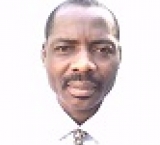
You need to register in order to submit a comment.